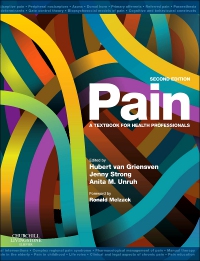
Pain - Elsevier E-book on VitalSource, 2nd Edition
Elsevier eBook on VitalSource

Now $60.29
The highly anticipated new edition of Pain: a textbook for health professionals (previous subtitle a textbook for therapists) has undergone a major rewrite in order to reflect the rapid developments in the field of pain management. It highlights an effective and evidence-based method, providing the theoretical basis to help with the assessment and management of persistent pain, while also discussing in depth a range of specific approaches.
Pain: a textbook for health professionals is written emphatically from a biopsychosocial perspective. In order to set the scene, the introductory section includes chapters on the patient’s voice and social determinants of pain. This ensures that the deeply personal and social aspects of pain are not lost among the more technical and biological commentary. These aspects provide an overall context, and are revisited in chapters on participation of life roles, work rehabilitation and psychology.
The basic science section includes key chapters on the psychology, neuroanatomy and neurophysiology of pain. This provides a basis for subsequent chapters on specific approaches such as pharmacology, physical therapy and complementary medicine. Pain in specific patient groups, including children, the elderly and those with cancer, are dealt with in separate chapters, as are pain problems such as complex regional pain syndrome and chronic spinal pain. Although the emphasis of the book is on long term pain, acute pain is discussed as a possible precursor and determinant of chronicity.
"The book covers a multitude of facets with regards relieving a patients pain, there are sections for pharmacological actions, rehabilitation, manual therapy and exercise therapy to name a few. The book is well researched and gives a very comprehensive overview of the major factors a therapist would require to treat pain." Reviewed by: Physical Therapy In Sport, Date: Oct 14
Newer Edition Available
-
- Patient-centred approach to care – advocates listening to the patient’s voice
- Covers social determinants of pain
- Guides the reader from pain psychology to the practical application of psychological interventions
- Learning aids – chapter objectives, reflective exercises, case examples, and revision questions
- Emphasizes an evidence-based perspective
- Written by an international team of experts
-
- topics such as pain in children and the elderly, pain education for professionals, disability and medico-legal aspects
- expanded focus on complex regional pain syndrome, acupuncture and psychology
- improved layout for a better learning and studying experience
-
1. Introduction to pain
Anita M. Unruh, Jenny Strong and Hubert van Griensven2. The patient’s voice
Mandy Nielsen3. Social determinants of pain
Kenneth D. Craig and Samantha R. FashlerSECTION 1 – OVERVIEW: WHAT IS PAIN?
4. The psychology of pain: models and targets for comprehensive assessment
Gordon J.G. Asmundson, Lydia Gomez-Perez, Ashley A. Richter and R. Nicholas Carleton5. Neuroanatomy of the nociceptive system
Mary Galea6.Neurophysiology of pain
Hubert van GriensvenSECTION 2 – ASSESSMENT AND MANAGEMENT OF PAIN
7. Pain assessment and measurement
Jenny Strong, Anita M. Unruh, Bill Vincenzino8. Psychological interventions: a conceptual perspective
Michael J.L. Sullivan9. Psychological interventions: application to management of pain
Patrick McGrath, Jill Chorney, Anna Huguet and Anita M. Unruh10. Neuropathic pain and complex regional pain syndrome
Nicola U. Cook and Hubert van Griensven11. Pain pharmacology and the pharmacological management of pain
Maree T. Smith and Arjun Muralidharan12. Manual therapy and influence on pain perception
Chris McCarthy13. Exercise therapy
Nadine Foster, Annette Bishop, Melanie Holden and Krysia Dziedzic14. Transcutaneous electrical nerve stimulation and acupuncture
Mark I. Johnson and Carole A. Paley15. Complementary therapy approaches to pain
Peter Mackereth, Ann Carter and Jacqui Stringer16. Workplace rehabilitation
L. Gibson and J. StrongSECTION 3 – SPECIAL ISSUES
17. Pain education for professionals
Emma Briggs and Sarah E. Henderson18. Pain in childhood
Anita M. Unruh and Patrick J. McGrath19. Pain in the elderly
Stephen J. Gibson20. Cancer pain
Sally Bennett, Geoffrey Mitchell and Jenny Strong21. Managing chronic spinal pain
Diarmuid Denneny22. Rehabilitation and the World Health Organization’s International Classification of Functioning Disability and Health
Karl S. Bagraith and Jenny Strong23. Participating in life roles
Jenny Strong24. Persistent pain and the law: clinical and legal aspects of chronic pain
George Mendelson and Danuta Mendelson25. Chronic pain and psychiatric problems
Harold Merskey26. Acute pain
Stephan A. Schug, Deborah Watson and Esther M. Pogatzki-Zahn27. Conclusions: the future
Hubert van Griensven, Jenny Strong, Anita M. Unruh


 as described in our
as described in our 